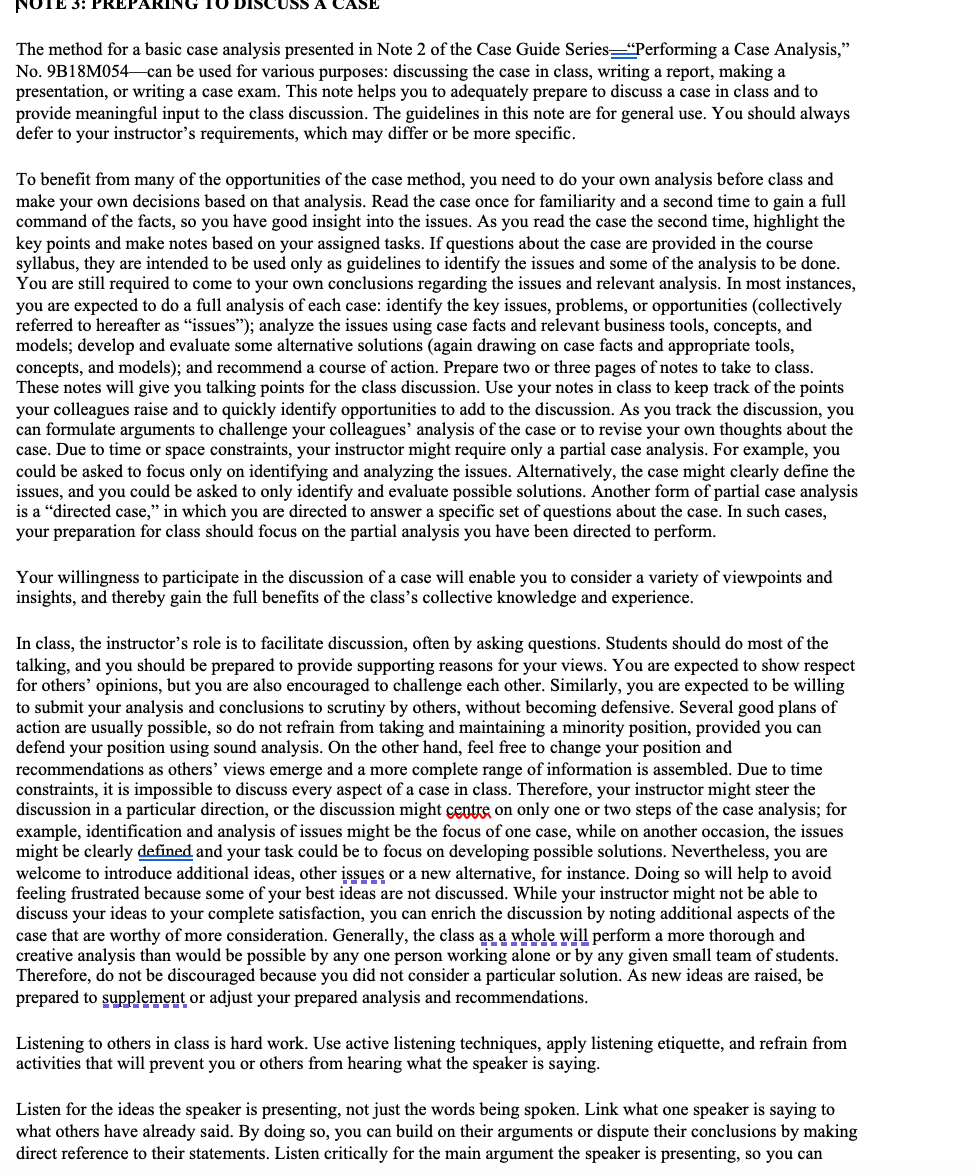Listening to others in class is hard work. Use active listening techniques, apply listening etiquette, and refrain from activities that will prevent you or others from hearing what the speaker is saying. Listen for the ideas the speaker is presenting, not just the words being spoken. Link what one speaker is saying to what others have already said. By doing so, you can build on their arguments or dispute their conclusions by making direct reference to their statements. Listen critically for the main argument the speaker is presenting, so you can
Listening to others in class is hard work. Use active listening techniques, apply listening etiquette, and refrain from activities that will prevent you or others from hearing what the speaker is saying. Listen for the ideas the speaker is presenting, not just the words being spoken. Link what one speaker is saying to what others have already said. By doing so, you can build on their arguments or dispute their conclusions by making direct reference to their statements. Listen critically for the main argument the speaker is presenting, so you can
Practical Management Science
6th Edition
ISBN:9781337406659
Author:WINSTON, Wayne L.
Publisher:WINSTON, Wayne L.
Chapter2: Introduction To Spreadsheet Modeling
Section: Chapter Questions
Problem 20P: Julie James is opening a lemonade stand. She believes the fixed cost per week of running the stand...
Related questions
Question
pleaz read image.
Question: Summary-Can you pick out and condense the main ideas of what you've read- namely can you tell me what you read in your own words? 150 words
Analysis- can you tell me why this is important, how it might be used, or what it may be applied to in this class or the real world. 100 words

Transcribed Image Text:understand how the speaker's argument differs from yours, and how the speaker uses case facts, concepts, and
models in analysis. Recognizing the logic of the speaker's argument aids you in structuring your own argument in
response. Active listening helps you build on analyses and arguments presented by previous speakers. Ask questions
that clarify a speaker's use of case facts, concepts, and models, and that clarify the conclusions drawn by the
speaker. Briefly summarizing a previous speaker's comments in your notes ensures that you have understood what a
colleague has said. This summary can also help you to establish and refine agreement among class members at
various stages of the case discussion process. Avoid making judgments about a speaker's ideas; quick judgments
limit your willingness to hear what the speaker is saying, which can lead you to discount the value of your
colleague's contribution to the case discussion. Having preconceived ideas about what a speaker might say can
cause you to tune out of the conversation; and when you tune back in, you could have missed a critical component
of the speaker's argument. Finally, approach a discussion with an open mind: you might discover during the class
discussion that you misinterpreted a fact or misapplied a concept or model, and that the analysis, alternatives, and
recommendation provided by others is more appropriate than yours.
Listening etiquette begins with focused attention on the speaker. Allowing colleagues to share what they have
diligently prepared shows respect for the time they have spent preparing and recognizes the value of their thoughts
and contributions. Give feedback to the speaker through your body language: maintain eye contact with the speaker,
nod and smile when appropriate, and physically lean into the conversation. Show respect by allowing the speaker to
completely finish speaking. A pause could simply be the speaker taking an opportunity to gather thoughts, not an
indication that the speaker has finished talking. Appropriate listening etiquette requires that you do not carry on side
conversations while a speaker has the floor. Side conversations distract not only the speaker but also those around
you and could prevent a speaker's ideas from being understood by the entire group. Appropriate listening etiquette
also requires that you not be distracted by electronic devices. Ensure that your laptop is open to your notes and the
case. Turn off your cellphone and put it out of sight. When your attention is distracted by electronic devices, you
also distract those around you and interfere with the collective understanding of the case. Good listening etiquette
helps you to develop essential management competencies, skills, and abilities. Your technical, analytical, problem-
solving, and creative skills will be sharpened as you evaluate your own analysis against that of your colleagues.

Transcribed Image Text:NOTE 3: PREPARING TO DISCUSS A CASE
The method for a basic case analysis presented in Note 2 of the Case Guide Series "Performing a Case Analysis,"
No. 9B18M054 can be used for various purposes: discussing the case in class, writing a report, making a
presentation, or writing a case exam. This note helps you to adequately prepare to discuss a case in class and to
provide meaningful input to the class discussion. The guidelines in this note are for general use. You should always
defer to your instructor's requirements, which may differ or be more specific.
To benefit from many of the opportunities of the case method, you need to do your own analysis before class and
make your own decisions based on that analysis. Read the case once for familiarity and a second time to gain a full
command of the facts, so you have good insight into the issues. As you read the case the second time, highlight the
key points and make notes based on your assigned tasks. If questions about the case are provided in the course
syllabus, they are intended to be used only as guidelines to identify the issues and some of the analysis to be done.
You are still required to come to your own conclusions regarding the issues and relevant analysis. In most instances,
you are expected to do a full analysis of each case: identify the key issues, problems, or opportunities (collectively
referred to hereafter as “issues"); analyze the issues using case facts and relevant business tools, concepts, and
models; develop and evaluate some alternative solutions (again drawing on case facts and appropriate tools,
concepts, and models); and recommend a course of action. Prepare two or three pages of notes to take to class.
These notes will give you talking points for the class discussion. Use your notes in class to keep track of the points
your colleagues raise and to quickly identify opportunities to add to the discussion. As you track the discussion, you
can formulate arguments to challenge your colleagues' analysis of the case or to revise your own thoughts about the
case. Due to time or space constraints, your instructor might require only a partial case analysis. For example, you
could be asked to focus only on identifying and analyzing the issues. Alternatively, the case might clearly define the
issues, and you could be asked to only identify and evaluate possible solutions. Another form of partial case analysis
is a "directed case," in which you are directed to answer a specific set of questions about the case. In such cases,
your preparation for class should focus on the partial analysis you have been directed to perform.
Your willingness to participate in the discussion of a case will enable you to consider a variety of viewpoints and
insights, and thereby gain the full benefits of the class's collective knowledge and experience.
In class, the instructor's role is to facilitate discussion, often by asking questions. Students should do most of the
talking, and you should be prepared to provide supporting reasons for your views. You are expected to show respect
for others' opinions, but you are also encouraged to challenge each other. Similarly, you are expected to be willing
to submit your analysis and conclusions to scrutiny by others, without becoming defensive. Several good plans of
action are usually possible, so do not refrain from taking and maintaining a minority position, provided you can
defend your position using sound analysis. On the other hand, feel free to change your position and
recommendations as others' views emerge and a more complete range of information is assembled. Due to time
constraints, it is impossible to discuss every aspect of a case in class. Therefore, your instructor might steer the
discussion in a particular direction, or the discussion might centre on only one or two steps of the case analysis; for
example, identification and analysis of issues might be the focus of one case, while on another occasion, the issues
might be clearly defined and your task could be to focus on developing possible solutions. Nevertheless, you are
welcome to introduce additional ideas, other issues or new alternative, for instance. Doing so will help to avoid
feeling frustrated because some of your best ideas are not discussed. While your instructor might not be able to
discuss your ideas to your complete satisfaction, you can enrich the discussion by noting additional aspects of the
case that are worthy of more consideration. Generally, the class as a whole will perform a more thorough and
creative analysis than would be possible by any one person working alone or by any given small team of students.
Therefore, do not be discouraged because you did not consider a particular solution. As new ideas are raised, be
prepared to supplement or adjust your prepared analysis and recommendations.
Listening to others in class is hard work. Use active listening techniques, apply listening etiquette, and refrain from
activities that will prevent you or others from hearing what the speaker is saying.
Listen for the ideas the speaker is presenting, not just the words being spoken. Link what one speaker is saying to
what others have already said. By doing so, you can build on their arguments or dispute their conclusions by making
direct reference to their statements. Listen critically for the main argument the speaker is presenting, so you can
Expert Solution
This question has been solved!
Explore an expertly crafted, step-by-step solution for a thorough understanding of key concepts.
This is a popular solution!
Trending now
This is a popular solution!
Step by step
Solved in 7 steps

Recommended textbooks for you

Practical Management Science
Operations Management
ISBN:
9781337406659
Author:
WINSTON, Wayne L.
Publisher:
Cengage,

Operations Management
Operations Management
ISBN:
9781259667473
Author:
William J Stevenson
Publisher:
McGraw-Hill Education

Operations and Supply Chain Management (Mcgraw-hi…
Operations Management
ISBN:
9781259666100
Author:
F. Robert Jacobs, Richard B Chase
Publisher:
McGraw-Hill Education

Practical Management Science
Operations Management
ISBN:
9781337406659
Author:
WINSTON, Wayne L.
Publisher:
Cengage,

Operations Management
Operations Management
ISBN:
9781259667473
Author:
William J Stevenson
Publisher:
McGraw-Hill Education

Operations and Supply Chain Management (Mcgraw-hi…
Operations Management
ISBN:
9781259666100
Author:
F. Robert Jacobs, Richard B Chase
Publisher:
McGraw-Hill Education


Purchasing and Supply Chain Management
Operations Management
ISBN:
9781285869681
Author:
Robert M. Monczka, Robert B. Handfield, Larry C. Giunipero, James L. Patterson
Publisher:
Cengage Learning

Production and Operations Analysis, Seventh Editi…
Operations Management
ISBN:
9781478623069
Author:
Steven Nahmias, Tava Lennon Olsen
Publisher:
Waveland Press, Inc.